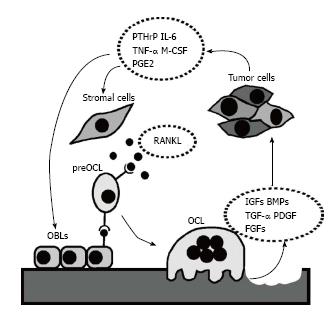Copyright
©2014 Baishideng Publishing Group Inc.
World J Clin Oncol. Aug 10, 2014; 5(3): 335-347
Published online Aug 10, 2014. doi: 10.5306/wjco.v5.i3.335
Published online Aug 10, 2014. doi: 10.5306/wjco.v5.i3.335
Figure 2 Schematic representation of the vicious cycle.
Under physiologic conditions, osteoblasts produce factors that regulate osteoclastogenesis (RANKL/OPG). Mature osteoclasts erode the bone matrix, allowing the release of factors (IGF-1, BMPs, TGF-β, PDGF, and FGFs). Tumor cells perturb this homeostasis by producing factors (PTHrP, IL-6, TNF-α, M-CSF, and PGE2) that favor osteoclastogenesis, with subsequent bone resorption and release of the growth factors stored in the bone matrix, which in turn enhance tumor growth. BMPs: Bone morphogenetic proteins; TGF-β: Transforming growth factor-β; FGFs: Fibroblast growth factor; IGFs: Insulin-like growth factors; PDGF: Platelet-derived growth factor; M-CSF: Macrophage colony stimulating factor; PGE2: Prostaglandin E2; OCL: osteoclast; OBL: osteoblast.
- Citation: Rucci N, Sanità P, Monache SD, Alesse E, Angelucci A. Molecular pathogenesis of bone metastases in breast cancer: Proven and emerging therapeutic targets. World J Clin Oncol 2014; 5(3): 335-347
- URL: https://www.wjgnet.com/2218-4333/full/v5/i3/335.htm
- DOI: https://dx.doi.org/10.5306/wjco.v5.i3.335









